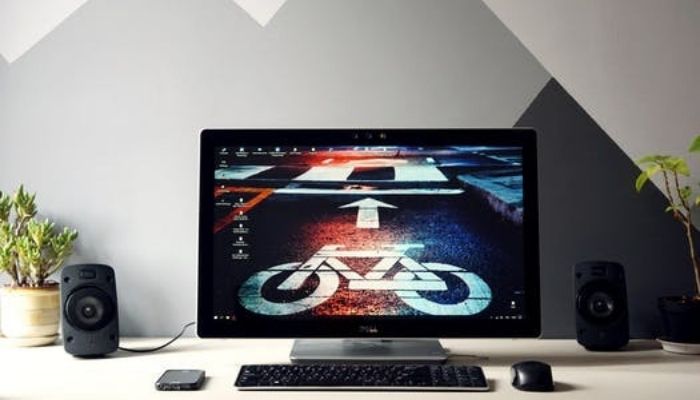Mounting a monitor to the wall takes up less space and provides a comfortable working/gaming environment. It is why the majority of modern displays are VESA-compliant.
It means they include all of the holes necessary for screwing the mount into the wall and hoisting it up. The thing you have to do is apply the directions and proceed on an enjoyable do-it-yourself project.
Numerous compelling arguments exist for elevating your LCD over your desk. It frees up a significant amount of desk space for starters, resulting in a less crowded workspace.
Additionally, it increases your viewing angles and enhances your general line of sight, which results in your neck being in a more natural posture and avoiding strain or stiffness over time.
Here’s all you need to know about How to Wall Mount a Monitor Without Holes, as well as a few things to consider before you get started.
However, some monitors are not VESA compliant and hence lack holes. Most people will suggest that you purchase a new display, but this will be costly.
If your monitor is still in good condition and functions properly, there is no reason to replace it. All you have is an adaptor to change a hole-free display to a VESA-compatible monitor.
What is the VESA standard?
VESA refers to as Video Electronics Standards Association is a professional association of video electronics industry specialists who analyze proposals and production standards to encourage industry uniformity.
VESA-Compliant Monitors
VESA-compliant televisions and monitors have four holes on the back. The VESA monitor mounting standards establish the following:
- The hole design on the monitor’s back
- The diameter of the screws uses to secure the mount to the monitor.
- The maximum weight that the mount can support Smaller, less expensive monitors,
Non-VESA-compliant monitors
Curved monitors and ultra-thin monitors typically have a hole layout incompatible with VESA mounts. It implies you must utilize the first-party manufacturer’s bespoke stands and mounts.
What to Look for When Purchasing a VESA Adapter Kit?
Let’s begin by selecting the appropriate VESA adapter kit. There are three VESA mount standards, and they are as follows:
- VESA MIS-D, 100/75, C.These mounts are secured to the display by M4 screws. It is not uncommon for monitors weighing less than 30 pounds to include this feature (or 14 kg). Small televisions and computer monitors are examples of this. Typically, these displays include a 100 × 100 mm/75 x 75 mm square hole layout.
- C. VESA MIS-E is mostly used for medium displays, which are typically below 50 lbs (or 23 kg). It features a 200 x 100 mm (rectangular) hole pattern, and M4 screws are also included for mounting attachments. An adapter kit converts an MIS-D plate into an MIS-E display gripper.
- VESA MIS-F, Class C M6, and M8 screws are utilized to secure this mount to a display. This one is followed by large televisions and 31″ and larger screens. Typically, the hole designs are spaced in increments of 200 mm.
If your monitor doesn’t follow any of these designs, it is still possible to obtain an adapter kit, but you will customize it. One’s can order these directly from the manufacturer.
Without-holes Mounting Techniques for Monitors
Before mounting any monitor to the wall, it is necessary to verify that the monitor’s back has VESA holes. We clarify this because some manufacturers do include holes but do an excellent job of concealing them.
Ensure you thoroughly inspect for VESA holes to see whether an adapter or other device is required or whether it can be mounted using the ways we will describe.
How to Mount a Monitor on the Wall Without Using Holes by VESA Adaptor Kit?

You require a VESA adaptor kit. This kit includes everything you need to wall attach your monitor. The following are the steps you should take:
- Purchase the appropriate VESA adapter kit for your monitor based on its requirements. Otherwise, it will be a financial waste.
- Remove the monitor’s stand after disabling all connections.
- With the adjustable clamps included in the kit, secure them with screws.
- Additionally, the kit includes anti-slip rubber mats. These are critical. It would help if you used them since they will safeguard your monitor.
- Ensure that all screws are securely fastened to the mount.
- Adjust the plates to the desired length.
- All that remains is to connect your monitor to the kit. It will readily secure in position due to its clamps. You risk your monitor slipping off if you do not utilize the rubber pads. Thus, as previously said, you must use must them.
It’s incredibly simple to install a monitor without drilling holes in the wall. Select the appropriate VESA converter kit and follow the on-screen instructions.
There is no reason to drill holes in your display and harm it, nor is there any reason to purchase a new monitor.
Manufacturer-Provided Adapters for Wall Mounting of a Monitor
Certain manufacturers, like Apple, do not certify their screens as VESA compliant, which means they cannot be installed. If you want to use a VESA mount for your screen, adapters for the manufacturer-supplied mounts are available.
They are frequently simple to install. Appropriate monitor mounting adapters make mounting of the devices safe.
- Consider these to be ‘aftermarket’ VESA mounts. It implies they comply with VESA requirements but must be purchased separately.
- Typically, these arrive pre-attached to your monitor and with instructions for mounting it to the wall. Typically, these adapters take the form of plates that attach to the back of your display.
- Depending on the plate you purchase, it may need to be screwed into your monitor. After the plate is mounted, it will include fittings that allow you to attach it to a wall mounting kit or a stand if desired.
- You may even purchase free-standing monitor mounts, which allow for an ergonomic arrangement without the need to install a mounting kit on your wall. It may be advantageous if you are renting an apartment or office space.
Adapters Clips for Wall Mounting of a Monitor
Another excellent option for putting your monitor without VESA mounting holes on the back is to purchase a clip mounting kit.
- This approach is significantly less intrusive than the previous one because it does not require screwing something into the backside of your monitor, which may deter some users.
- These kits are commonly accessible from internet shops, and while the type you require will rely on the size of your monitor, most of them are easily adaptable to accommodate a range of screen sizes.
- This type of mounting kit often has four ‘arms’ that clip onto various sections of your monitor, dispersing the weight of your monitor evenly.
- Then, secure it to the wall using a mounting kit and bracket. Additionally, adapter clips with adjustable movement are available.
- The arms extend somewhat beyond the monitor’s boundaries, allowing you to see them slightly around the screen’s edge. It may not be everyone’s preference, but everyone we’ve discovered is always subtle.
It’s a good choice for anyone hesitant to screw anything into their monitor. Due to their compatibility with most monitors and their low price, they are frequently a suitable alternative for people looking to improve their ergonomic setup on a budget.
Frequently Asked Question
Do All Monitors Have Mounting Holes?
The straightforward answer is that you can mount all monitors. The majority of monitors sold now include a mounting plate on the back, making it incredibly simple to mount them using popular monitor mounting tools. Even older monitors and CRTs without this configuration can be attached.
How Do I Know If My Monitor Is Wall Mountable?
Inspect the back of your computer monitor to discover if it meets VESA requirements. If your monitor complies, you should notice the conventional four-hole screw pattern on the rear.
The most typical screw hole layout is 75 x 75 mm or 100 x 100 mm, whereas larger displays will have 200 x 100 mm screw holes.
Is My TV Too Heavy to Mount?
In general, the size and weight of televisions are inversely proportional. The size of the television determines its weight.
The mounts will be rated for maximum weight and compatible with various VESA standards.
As long as your LCD meets the specified specifications, the mount should easily support the weight of your television.
Can You Mount a Curved Monitor?
To begin, curved screens provide significant challenges due to their characteristic shape. Compared to flat displays, which normally flush with the surrounding wall, curved screens require special mounting and positioning.
Conclusion
As you can see, a hole-free monitor is not a total loss. There are several options. To prevent drilling holes in the wall, you can buy an adapter from the manufacturer, a wall mount adapter clip, or an adapter clip.
Newer monitors, such as Apple’s, do not come pre-drilled for VESA installation, but you can buy ‘aftermarket’ kits to ensure compliance.
The manufacturer may not have adapter kits available if you have an older model. In this case, adapter clips are available. The size of your screen will decide which one you should buy. They are fairly ubiquitous, so you should be able to locate one that fits your display.
